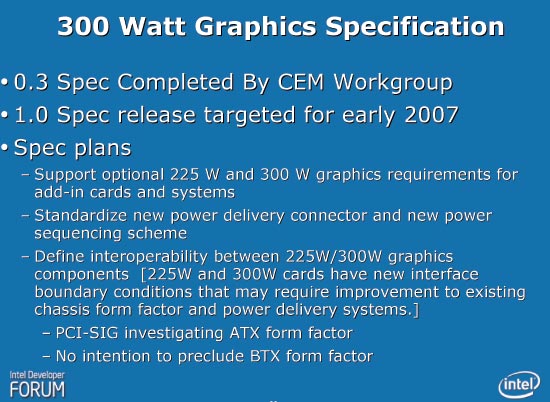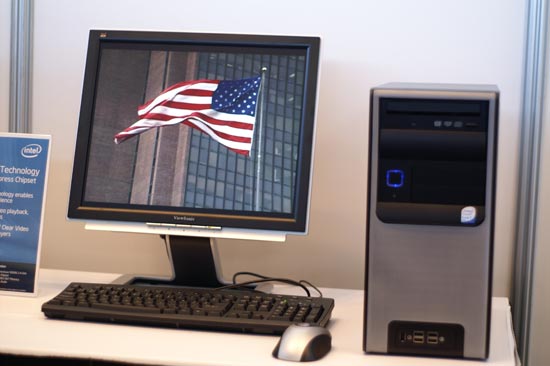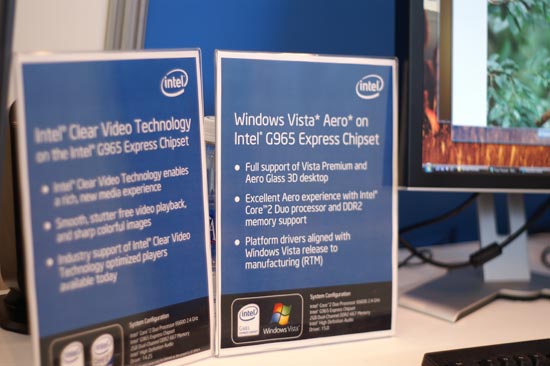IDF Fall 2006 - Day 2: Geneseo, Santa Rosa, Memory Roadmap and More
by Anand Lal Shimpi on September 28, 2006 3:43 AM EST- Posted in
- Trade Shows
Brief Mention of 300W Graphics
It looks like there are going to be two high end GPU specs for power, with a 225W and a 300W spec. We mentioned during Computex that we're expecting the upcoming DX10 GPUs from ATI and NVIDIA to begin pushing the power envelopes much higher than we've seen in the past, and the fact that we're seeing discussion of specs for 225W and 300W GPUs means that we should probably expect even higher power consumption cards from graphics vendors.

Intel Does Graphics
Intel was cautiously quiet on the subject of its own entry into the discrete graphics market. Although ATI is convinced that Intel will make a significant entry into the graphics market in the next two years, Intel isn't saying anything at all.

Intel's new integrated graphics running Vista with Aero enabled
We are looking at Intel's latest G965 graphics solution, which is a significant departure from Intel integrated graphics offerings of previous chipsets in terms of being a more modern architecture. We are working out some driver issues with Intel currently and hope to be able to provide at least a first look at the new integrated graphics core in the coming weeks.

Intel's G965 integrated graphics running the HQV video quality benchmark
While Intel wouldn't confirm plans to produce higher end graphics cores, its representatives did confirm that we would see further segmentation in the integrated market. Currently Intel is offering two versions of its integrated graphics, a slower version found in the Q965 chipset and a faster version in the G965. Within the next 12 months you can expect Intel's integrated graphics to segment more dramatically. At the very low end you can imagine a corporate desktop integrated graphics solution that can basically offer video decode acceleration and support for Vista's Aero Glass UI, but a terrible performer in games. Then, in the mid range, you'd have today's G965 graphics offering and to round things off Intel would create an even higher end integrated graphics solution to offer better performance for entry-level gamers. In the past, our expectations for a minimum level of gaming performance and Intel's have not lined up even in the least, but we're hoping with this and the next generation of Intel integrated graphics that we'll see more of what we've been asking for, for years.

Whether or not Intel will make an entry into the discrete GPU market has yet to be seen, but one thing is for sure - Intel is definitely taking its graphics cores more seriously.










7 Comments
View All Comments
porkster - Thursday, September 28, 2006 - link
If you ask me, laptop graphics is a major issue at the moment.Intel really needs to bring forth the Santa Rosa chipset to set a new bench level for gfx. x3000 maybe just enough to move upto, but even the power of the gfx intergrations, isn't that great.
Vista will make most laptop's second generation, the day it is released.
johnsonx - Thursday, September 28, 2006 - link
It's been speculated that AMD would have something to show in a hotel room across the street from IDF as they have in past years. So far it seems AMD is silent this year. A bad sign? AMD not as close on quad-core and/or K8-L as everyone has been hoping?What's the industry scuttlebutt on this?
smitty3268 - Thursday, September 28, 2006 - link
I was wondering the same thing. Perhaps K8L won't actually be any faster than current Conroes?fitten - Thursday, September 28, 2006 - link
You know... as much as people say this, it's odd that the aging FSB architecture is in the fastest system on the market right now... even faster than "newer" non-FSB architecture. Sure, it may not post as high synthetic benchmark bandwidth and latency numbers but when running applications, it sure seems to do pretty well. Sure, a new interconnect architecture might make it even faster and cooler but simply because the FSB is "aging" doesn't necessarily imply that it doesn't work.
Xenoterranos - Thursday, September 28, 2006 - link
While I agree with your point, at the crux of the argument is the question about when FSB will be too out dated. We all know it doesn't scale that well, and it's a testament to Intel's engineering teams that they are able to make it work so well. On the Xeons we see them moving toward dual FSB's, considering that we now have dual core processors, maybe this isn't that bad of a sign for the good ol FSB. HyperTransport is making great strides, and I would love to see Intel direct some of it's considerable brainpower at (co?)developing a new system like that instead of finessing all the power they can out of the one they have. I think they really believe that FSB is the way to go right now, but I would seriously doubt they have no plans to move to something like HT in the future.fitten - Friday, September 29, 2006 - link
Intel's serial interconnect that they're working on is called CSI.Clauzii - Thursday, September 28, 2006 - link
I find it kind of funny to see Vista running on MAC OS ;)